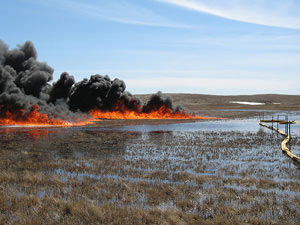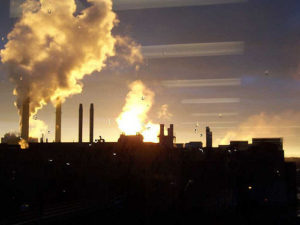How Much Oil Spilled on North Dakota? No One Knows
A ruptured pipeline last month spilled at least 20,000 barrels of crude oil that went undetected until a local farmer stumbled across it while harvesting wheat. Now experts say the spill estimate is a weak guess, and no one knows how much oil was lost. Either way, it’s among the largest in state history -- and a troubling sign of incompetence, or worse.
A leak likely caused by a rusty pipe has pointed up some of the dangers and regulatory shortcomings of moving oil through remote regions — and created a localized environmental disaster in North Dakota, where the new oil and gas drilling boom has had significant environmental and economic effects.
The spill, via a Tesoro pipeline, was discovered on Sept. 29 by local farmer Steve Jensen who smelled oil in the air as he was harvesting wheat. Tracking down the odor, he discovered a 7.3 acre lake of crude oil covering part of his farmland. He immediately got in touch with Tesoro, according to The Associated Press, but state regulators didn’t know until more than a week later that a spill Tesoro initially estimated at 750 barrels was much, much larger. A public announcement wasn’t made until Oct. 10, a delay that Worldmag.com says raises questions about whether state regulators are too cozy with the people they are supposed to be monitoring:
If oil spills and no one is around to see it, does the public have a right to know?
That’s the question North Dakota residents are asking this week after a pipeline rupture sent more than 20,000 barrels of crude oil into a wheat field in one of the largest spills in state history. Tesoro Corp. reported the spewing oil to the North Dakota Health Department on Sept. 29 after a local farmer discovered it. But state officials waited more than two weeks to tell the public about the spill—and this only after an inquiry from the Associated Press.
Some environmentalists are concerned the delay suggests a too-cozy relationship between the oil industry and state regulators. “It’s definitely worrisome,” said Don Morrison, executive director of the Dakota Resource Council. “There is a pattern in current state government to not inform the public.”
Meanwhile, experts say the leak estimate is based on insufficient data, and that no one really knows how much oil spilled from the pipeline into the ground. But better monitoring, they say, could eliminate the guesswork behind the estimate.
Tesoro is cleaning up the spill, a process that so far has involved burning off surface oil, then digging deep trenches to vacuum up oil-soaked dirt.
As for Jensen, the farmer, at last word he was trying to find out exactly how much of his crop was damaged by the spill.
—Posted by Scott Martelle.
Your support matters…Independent journalism is under threat and overshadowed by heavily funded mainstream media.
You can help level the playing field. Become a member.
Your tax-deductible contribution keeps us digging beneath the headlines to give you thought-provoking, investigative reporting and analysis that unearths what's really happening- without compromise.
Give today to support our courageous, independent journalists.








You need to be a supporter to comment.
There are currently no responses to this article.
Be the first to respond.